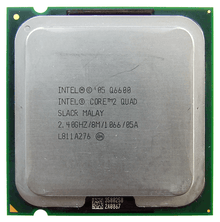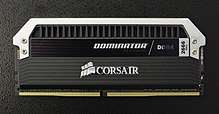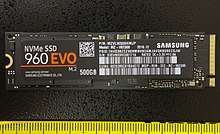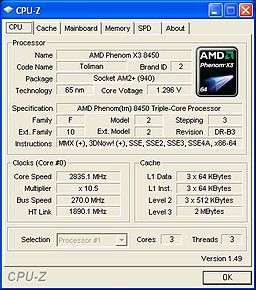Enthusiast computing
Enthusiast computing refers to a sub-culture of personal computer users who focus on extremely high-end computers. Manufacturers of performance-oriented parts typically include an enthusiast model in their offerings. Enthusiast computers (often referred to as a "box", "build", or "rig" by their owners) commonly feature extravagant cases[1] and high-end components, and are sometimes liquid cooled.
Although high-end computers may be bought retail in the same manner as the common computer, they are frequently assembled by their owners. Enthusiasts assemble their systems to simply enjoy the best images and effects a new PC game has to offer, to design an aesthetically pleasing PC, or even simply to obtain the best possible performance at a variety of tasks.
Influence of gaming
Games have historically been the driving force behind the rapid pace of consumer hardware development. For example, The 7th Guest and Myst helped drive the adoption of CD-ROMs. Intel and AMD both incorporated instruction sets such as MMX, 3DNow!, and Streaming SIMD Extensions into their processors to support the PC's growing role as a home entertainment device.
More recently, however, other types of applications have piqued the interest of computing enthusiasts. Scientific distributed computing tools such as Folding@home, GIMPS, and SETI@home, along with other computationally intensive tasks, including cryptocurrency mining, may also push CPUs and GPUs to their limits, and may also serve as a means of competition, such as tracking how many data sets a user has completed.
Cost
An enthusiast PC implies the early adoption of new hardware, which is sold at a premium price. As an example, the video card ATI Radeon 9700 Pro was released at US$399 in 2002.[2] Many gaming PCs support the use of multiple video cards in SLI or CrossFire, making it possible to spend thousands of dollars in graphics cards alone.[3]
Beyond a certain level of performance, price increases dramatically while offering smaller increases in performance; this is a classic example of diminishing returns. For example, a user who purchased 4 Titan X graphics cards in 2015 would have spent over $4000, even though next year's high-end graphics card, the GTX 1080, in 3-way SLI would offer a significant increase in performance at less than half the price.
Hardware description
Graphics
Gaming PCs use hardware accelerated video cards which offer high-end rasterisation-based rendering/image quality. The graphics card is the most important part determining the capabilities of a gaming PC.[4] Memory capacity on 3D cards is usually at least 256 MB to 12 GB. The amount of video RAM is more important while gaming in higher resolution or using high resolution textures and extensive modding. Having at least 2GB to 4GB of VRAM or more is suggested for today's standards when gaming. The type of memory used, however, is an important factor. Current VRAM standards are at GDDR5, GDDR5X, GDDR6, and HBM2. Modern graphics cards use the PCI Express expansion slot. Two or more graphics cards can be used simultaneously on motherboards supporting SLI or ATI CrossFire technology, for nVidia and AMD based cards respectively. Both technologies allow for between two and four graphics cards, although nVidia recommends only using multiples of the same model, to be used in unison to process and render an image.[5]
A high-end graphics card will also use more electricity, or have a higher power draw, than a lower-end card. This power draw only increases as the number of graphics cards increases, adding another cost to a high-end "rig". Enthusiasts also tend to overclock their graphics cards which does add power draw. However, as the number of graphics cards increases, the performance gains by adding another graphics card decreases significantly due to the complexity of more than two GPU's communicating to each other in an efficient way. This is another example of depreciating returns.
A well-made, top-class video card should at least adequately play all the new games for at least two years, though hardcore gamers will eagerly spend the money to upgrade more often. To keep up with the technology while spending the least amount of money, waiting two years to upgrade is the most accepted compromise." - Microsoft.com[6]
Display
It is clear that a fast response time and high refresh rate is desired in order to display smooth motion. A framerate of 60 frames per second (FPS) is generally the minimum acceptable framerate in a video game for enthusiasts, with some enthusiasts preferring 144 FPS or even 165 FPS, to match the refresh rate of their monitor (144 Hz or 165 Hz, respectively). Some gaming monitors can be overclocked to achieve even higher refresh rates. Apart from the primary display, some enthusiasts choose to use a secondary display or more to their PC. Many players game using 3 monitors, which requires 3 times the graphics performance.
Some monitors are designed exclusively for gamers, featuring higher refresh rates and improved response times at the expense of a lower resolution.[7] E-sports, or competitive gamers, often favor higher framerates at the expense of reduced color accuracy, preferring TN panels over IPS panels.
Audio
Gaming PCs are usually equipped with a dedicated sound card and speakers in a 5.1 or 7.1 surround sound configuration. The speaker setup or a set of quality headphones is required to enjoy the advanced sound found in most modern computer games.[8] Sound cards have hardware accelerated technologies, such as EAX. The Sound Blaster X-Fi, with its Fatal1ty editions having 64 MB of onboard RAM (unmatched for a sound card), targets enthusiasts as its main demographic, having a dedicated "gaming mode".[9]
Physics
While physics cards are now available, compatibility and performance increases are still debated. Some people have experienced performance downgrades in GRAW,[10] one of few games currently available that take advantage of additional physics hardware. Graphics card manufacturers plan on including PPUs on their chipsets and also adding a slot for a third graphics card (in addition to the usual 2 slots for SLI or Crossfire setups) to act as a PPU.[11] At the moment, the cards are expensive and neither widely used nor widely supported in games. Recently Nvidia cards support the physics calculations that dedicated physics cards were made for. Nvidia physics software is known as "PhysX".
CPU

The CPU is mainly responsible for computing physics, AI and central game processes. Modern gaming PCs use high-end processors. With the rise of multi-threaded games, multi-core processor setups have become more necessary than ever. Furthermore, an ample amount of L2 Cache within the CPU, generally 4 MB or more, is recommended to reap the benefits of even faster game performance. In addition, a gaming processor should be capable of running at least the SSE3 instruction set extension, which is available with all modern CPUs.[12]
Memory

Random access memory, or RAM, acts as a cache for non-graphical resources that games use. Enthusiasts will often purchase the fastest RAM, which has a lower latency, thus offering negligible performance increases in most cases. For gaming, a higher frequency of memory than would be necessary for an average computer user can offer some benefits. This has led to certain motherboards supporting RAM overclocking, with the new XMP standard. As RAM frequency is increased, however, the stability of the system decreases, increasing the risk of random computer shutdowns.
8 GB is usually the recommended amount of memory for gaming computers, as some 64-bit games can use over 4 GB of RAM.
RAM capacity is also an issue with gaming PCs, and usually at least 4 GB or more, depending on how many RAM slots the board can hold, and whether it supports 4 or 8 GB modules. The current maximum amount supported (for quad-channel configuration) on consumer hardware is 128 GB, with 8 slots on some LGA 2066 motherboards, each slot supporting up to a 16 GB DIMM.
Storage

In gaming PCs, fast hard drives are very desirable. Having a faster hard drive will result in shorter loading times in games. For this reason, some gaming PCs use certain RAID setups to lower latency and increase throughput to mass storage.[13] Since the space taken up by games is nominal compared to the total availability on modern hard drives, speed is preferred over capacity.
Recently, solid-state drives have become popular, which offer significantly higher speeds than magnetic hard drives. Though originally more expensive, the price has significantly dropped. The performance of SSDs is now considered a minimum in a "rig", and some consider them necessary even in budget PCs.
Currently M.2 drives have become the newest form of lower-cost fast storage. These drives connect straight into the motherboard, allowing for extremely fast data read & write speed. These drives are very fast and most NVME M.2 drives easily pass the speed of SATA SSDs.
Networking
While typical computers, including high-end systems, tend to use wireless connections to connect to other computers as well as a router, gaming PCs often use Ethernet cables for the fastest and most reliable connection possible.[14] Some companies sell dedicated network cards to reduce lag in multiplayer games. A dial-up Internet connection is not an acceptable solution due to the very high latency (~400ms is common). Mobile broadband connections can also cause the same undesirable effects as dial-up connections, but can be considered less substantial, with latency of or exceeding 150ms, less than 100ms being desirable in a first-person shooter.
Interface
There are many hardware interfaces designed specifically for gaming. Such interfaces include keyboards and mice built for gaming (these typically include additional keys or buttons for game-related functions as well as LCD screens, higher sensitivity (for mice), better aderency (keyboard/mouse) and less/more friction depending on the user's needs[15]), joysticks, gamepads, steering wheels, PC-compatible airplane gauges and panels,[16] etc. A keyboard and mouse is the preferred method for most games, giving the best speed and accuracy. Touch screens are rarely used for PC gaming at this point. "Haptic feedback" commonly known as force feedback, allows for greater immersion in the games played. While there are no keyboards that support haptic feedback, some mice and most forms of game controllers do.
Case, power supply, cooling, and other case accessories
As well as the computing components themselves, case and related accessories often form a target for enthusiast attention, for functional and aesthetic reasons.
- Computer power supplies may be selected for very high quality electrical stability and performance, so that the high speed electronics reliant on them will not suffer from irregularities or disruption, and so that high power processors and graphics cards can be properly supplied with the often high levels of current needed. Power supply reviews for enthusiasts may, for example, take apart the item to identify the exact manufacturers of components, the types and sources of capacitors or power regulation circuitry involved, the quality of PCB soldering, and the calibre of any wiring.
- Quiet computing is a specialist aspect of enthusiast activity, whereby the user aims to ensure the computer runs very quietly, with the goal of enjoyable ambience. Fans, hard drives, and any other noisy components may be selected for their acoustic properties, and then mounted in ways that dampen vibration and provide acoustic isolation.
- Cooling systems may receive careful attention, both to ensure high quality airflow and reduced operating temperatures under heavy workloads or intense activity, to support overclocking, and as part of quiet computing as well.
- Computer cases, especially of gaming computers, are often selected with care, for their aesthetic and functional value. Functionally, the case must be able to provide cooling for high-end, possibly overclocked components, and have room for expansion and customization. Aesthetically, case modding usually includes features that show off the creator's intent: clear sides to reveal the internal components and layout, which may be adorned with LEDs, images on the graphics cards or power supply units.
- Liquid cooling, in which a liquid is used to cool a part of the computer, is becoming cheaper and more available. While much more expensive than an ordinary fan, it transfers heat more efficiently and is generally quieter. As building a computer becomes more of an enthusiast activity, due to the rise of tablets, laptops, and cell phones, more and more cases appeal to watercooling setups.
Performance and benchmarks
As a general guideline, enthusiast PCs must achieve high scores on 3D benchmarks such as 3DMark when first built or upgraded. Enthusiasts who know how to overclock sometimes do so to prolong the usefulness of their hardware. The highest results are always achieved by overclocking.[17]
However, synthetic benchmark results rarely equate to real application performance, as measured by framerate. The framerate is measured in frames per second, which refers to the number of times the video card recalculates the image shown on screen. While frame rates above 60 FPS (standard NTSC framerate) become increasingly difficult to distinguish with the human eye, enthusiast PCs with a multi-video card setup often boast framerates in excess of 100 FPS. To maintain a challenge, the standard for comparison is constantly refreshed with new games and higher detail settings.
Overclocking

Overclocking is used by enthusiasts to achieve component or system performance that exceeds the manufacturer's officially stated specification. Overclocking is such a significant part of enthusiast culture that popular and widely respected websites such as Anandtech and Tom's Hardware often include overclocking as part of a review. Hardware manufacturers release high-end components that facilitate overclocking. Examples include CPUs with unlocked multipliers, oversized heatsinks or water cooling, and motherboards with user-configurable voltages and incremental bus speeds. "Professional" overclockers commonly overclock only one core of processors, typically older AMD CPUs, to obtain extreme numbers like 7 GHz.
Some system builders and part manufacturers now offer factory overclocking, which is covered under warranty. Alternatively a manufacturer or user may seek individual components that overclock, in order to buy a cheaper product that will prove to run to a higher quality product's standard.
There are significant hazards to be aware of when overclocking a computer. At a mundane level some components will not work under too high a demand, and the computer will not work until the overclocked demands are reduced or mitigated. More seriously, some components are capable of being damaged or destroyed by increased heat or voltages routinely caused by overclocking if the user is reckless or uninformed, and therefore caution and some level of prior understanding is needed.
In particular, overclocked CPUs (central processing units) generally run hotter than normal, and components such as CPUs, memory controllers, graphics cards and RAM may require higher voltages to produce higher performance. The higher voltage results in increased heat and can stress the electrical channels of the components. This can cause damage, degradation, or fatal failure.
While most components oftentimes see marginal or barely perceptible benefits, CPUs see much larger performance improvements, especially when using a high-end cooling solution. However, CPUs are also the most complex component to overlock, making it significantly harder for newcomers and beginners to achieve great numbers.
GPUs (Graphics processing units) on the other hand although overclockable rarely see significant performance gains while results can be wildly inconsistent. "The Silicon lottery" is a term used by overclocking enthusiasts to describe components that turned out better during the manufacturing process, therefore making them more durable (this can also arise with CPUs, but is most often referenced concerning GPUs), capable of handling the pressure of overclocking better; meaning more overclocking headroom. Regardless, GPUs are the most popular component to overclock despite downsides.
In terms of complexity, RAM (Random-access memory) is closely tied with CPUs, but performance gains are not as significant. In particular, DDR4 SDRAM is more prominent compared to its predecessors DDR3 and DDR2. However, even though higher speeds aren't usually very noticeable in most applications there are a few scenarios where overclocking RAM is legitimately important. One such scenario is with AMD Accelerated Processing Units where the CPU and GPU are combined in one chip, meaning they have to share memory resources. Typically, a GPU has its own RAM that is much faster than desktop DDR3 or DDR4 SDRAM, but with an APU it has to work with slower desktop RAM. In this particular scenario, overclocking your RAM is actually highly recommended and will give you meaningful performance increases.
See also
References
- 25 Awe Inspiring Custom Computer Case Mods Archived 2009-01-21 at the Wayback Machine, 2008/05, The Hottest Gadgets
- Shimpi, Anand Lal (2002-08-19). "ATI Radeon 9700 Pro - Delivering as Promised". AnandTech. Retrieved 2006-07-11.
- Wilson, Derek (2006-03-09). "NVIDIA's Tiny 90nm G71 and G73: GeForce 7900 and 7600 Debut". AnandTech. Retrieved 2006-07-11.
- "GPU vs. CPU Upgrade: Extensive Tests". Tom's Hardware. 2008-05-15. Retrieved 2008-05-26.
- Tricarico, Ben (2020-05-09). "SLI Troubleshooting Tips". Nvidia. Retrieved 2020-05-09.
- "Windows XP: Video Card 101". Microsoft. 2003-11-10. Archived from the original on 2006-07-15. Retrieved 2006-07-11.
- https://www.amazon.com/BenQ-XL2411Z-Monitor-Supported-seamless/dp/B00ITORITU
- "Hear It All with Surround Sound". Microsoft. 2003-11-10. Archived from the original on 2006-04-24. Retrieved 2006-07-11.
- "Sound Blaster X-Fi Fatal1ty". Creative Labs. Archived from the original on 2006-07-11. Retrieved 2006-07-11.
- Wilson, Derek (2006-03-05). "Exclusive: ASUS Debuts AGEIA PhysX Hardware". AnandTech. Retrieved 2006-07-11.
- Justice, Brent (2006-03-20). "nVIDIA SLI Physics Tech Preview". [H]ard|OCP. Archived from the original on 2006-06-30. Retrieved 2006-07-11.
- Wall, Michael. "Optimizing Games for AMD Athlon 64 processors in 2006 and beyond" (PDF). Advanced Micro Devices. Archived from the original (PDF) on 2006-09-01. Retrieved 2006-07-24.
- "Why upgrade your hard drive?". Alienware. Archived from the original on 2006-02-22. Retrieved 2006-07-23.
- Mitchell, Bradley. "Wireless vs Wired LANs". About. Retrieved 2006-07-11.
- "Logitech G15 gaming keyboard". Logitech. Archived from the original on 2006-09-15. Retrieved 2006-07-23.
- "The Real Cockpit". TRC Development. Retrieved 2006-07-23.
- "3D Mark hall of fame". Futuremark. Retrieved 2006-07-12.